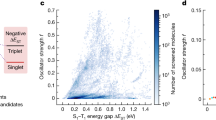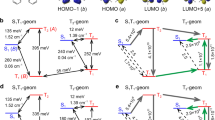Abstract
Birks and Christophorou1, examining mixed excimers, reported that the sum of the fluorescence intensities from two solutions, one containing c moles of pyrene (component A) and the other c moles of 1-methylpyrene (B). is equal to the fluorescence intensity from a mixed solution containing c moles each of A and B.
This is a preview of subscription content, access via your institution
Access options
Subscribe to this journal
Receive 51 print issues and online access
$199.00 per year
only $3.90 per issue
Buy this article
- Purchase on Springer Link
- Instant access to full article PDF
Prices may be subject to local taxes which are calculated during checkout
Similar content being viewed by others
References
Birks, J. B., and Christophorou, L. G., Nature, 196, 33 (1962).
Förster, Th., and Kasper, K., Z. Phys. Chem., NF, 1, 275 (1954).
Kasper, K., Z. Phys. Chem., NF, 12, 52 (1957).
Selinger, B. K., dissertation, Stuttgart (1964).
Author information
Authors and Affiliations
Rights and permissions
About this article
Cite this article
SELINGER, B. Fluorescence of Organic Mixed Excimers. Nature 203, 1062–1063 (1964). https://doi.org/10.1038/2031062b0
Issue Date:
DOI: https://doi.org/10.1038/2031062b0
This article is cited by
-
Excimers and Exciplexes
Nature (1967)
Comments
By submitting a comment you agree to abide by our Terms and Community Guidelines. If you find something abusive or that does not comply with our terms or guidelines please flag it as inappropriate.



